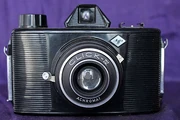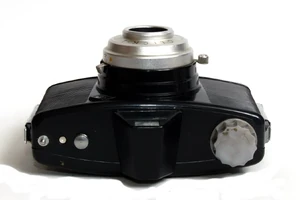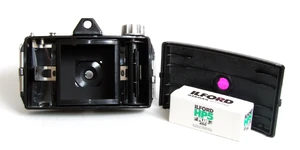(w/ previous edit accidentally deleted a photo. restored previous version and redid edits: just corrected some typos) Tag: Visual edit |
(This is a 1967 Mamiya Super 23) Tag: Visual edit |
||
| Line 37: | Line 37: | ||
Agfa Click-I 08.JPG|<small>images by [http://www.flickr.com/photos/s-demir/6749162157/in/photostream/ Süleyman Demir]</small> |
Agfa Click-I 08.JPG|<small>images by [http://www.flickr.com/photos/s-demir/6749162157/in/photostream/ Süleyman Demir]</small> |
||
</gallery> |
</gallery> |
||
| + | This is a 1967 Mamiya Super 23. I wanted a 6x9cm camera for landscape work so I could make big prints. I had a 6x9cm roll back for my view camera but I always felt if I was going to carry a view camera, I may as well shoot 4”x5”. I was hoping to get a camera that handled quickly, had good optics and had a rangefinder that wasn’t “squinty”. After researching, I settled on the Mamiya system. The Super 23, and its cousin, the Universal, were the last of the Mamiya “Press” camera line. However by 1967, most press photographers had moved to 35mm camera. The Press cameras did find a niche in the professional photography markets for portrait/ wedding, architectural and studio photography. The Super 23 is a true all-mechanical, classic manual camera with no batteries, no meter and no automation. |
||
| + | [[File:00WZtO-248293684.jpg|thumb|220x220px]] |
||
==Notes and references== |
==Notes and references== |
||
<references/> |
<references/> |
||
| + | 2. [http://suadiennuochanoi.vn/10/sua-chua-may-bom-nuoc-tai-nha sua may bom nuoc], [[sua dien nuoc|<nowiki/>]][http://suadiennuochanoi.vn/11/sua-chua-bao-duong-lap-dat-dieu-hoa sua dien nuoc] , [http://suadiennuochanoi.vn/11/sua-chua-bao-duong-lap-dat-dieu-hoa sua dieu hoa] |
||
| − | |||
==Links== |
==Links== |
||
Revision as of 11:49, 8 December 2014
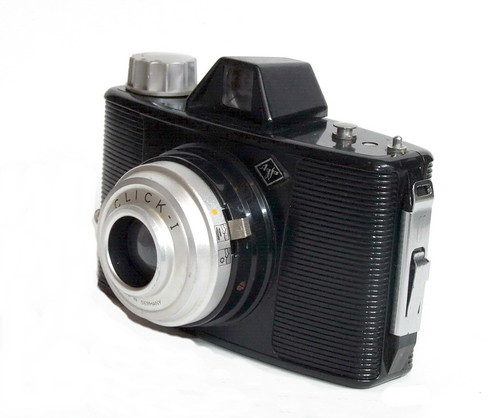
|
| Agfa Click-I image by Süleyman Demir (Image rights) |
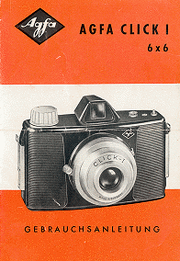
Click-I is a medium format film viewfinder camera manufactured by Agfa Kamerawerk AG, Munich, Germany and produced between 1958-70.
An inexpensive snapshot camera that makes photography really simple. If there is Clack there have to be Click also. Click could be considered as an evolution model of Clack (You can easily prove it by pronouncing "clack" and "click" definitely the sound goes upwards.) A new feature is an internal yellow filter, instead the close up lens in Agfa Clack. Body material is plastic and the shutter noise is civilized. [1]
The bent back cover plays a role as a film pressure plate and provides for a steady and good sharpness.
The other cameras in the Click line are Agfa Click-II, Agfa Click III, Agfa Click IV and Agfa Click V.
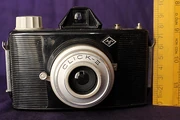
Click III
Specifications
- Film 120 roll, picture size 6x6cm
- Lens: Meniscus lens 72.5mm f/8.8 filter slip-on

Click IV
- Aperture: f/8.8 and f/11; setting: lever and cloudy and sunny setting icons on the lens-shutter barrel
- Internal yellow filter: set to yellow dot
- Focusing: fixed focus
- Shutter: single speed rotary shutter, speed about 1/30
- Synchronised for Agfa Clibo flash unit, attach buttons on the right of the top plate
- Cocking lever and shutter release: by the same lever, on the lens-shutter barrel
- Winding knob: on the top plate
- Viewfinder: simple Galilei
- Back cover: removable, w/ red window, opens by a latch on the left of the camera
- Tripod socket: ¼”
- Strap lugs
- Body: plastic; weight: 183g
- Serial no.: none
This is a 1967 Mamiya Super 23. I wanted a 6x9cm camera for landscape work so I could make big prints. I had a 6x9cm roll back for my view camera but I always felt if I was going to carry a view camera, I may as well shoot 4”x5”. I was hoping to get a camera that handled quickly, had good optics and had a rangefinder that wasn’t “squinty”. After researching, I settled on the Mamiya system. The Super 23, and its cousin, the Universal, were the last of the Mamiya “Press” camera line. However by 1967, most press photographers had moved to 35mm camera. The Press cameras did find a niche in the professional photography markets for portrait/ wedding, architectural and studio photography. The Super 23 is a true all-mechanical, classic manual camera with no batteries, no meter and no automation.
Notes and references
- ↑ from The Camera Site
2. sua may bom nuoc, sua dien nuoc , sua dieu hoa
Links
- in Freepic
- in wolfgangas-photographica
- in the camerasite
- in collection-appareils.fr collection-appareils.fr Click I
